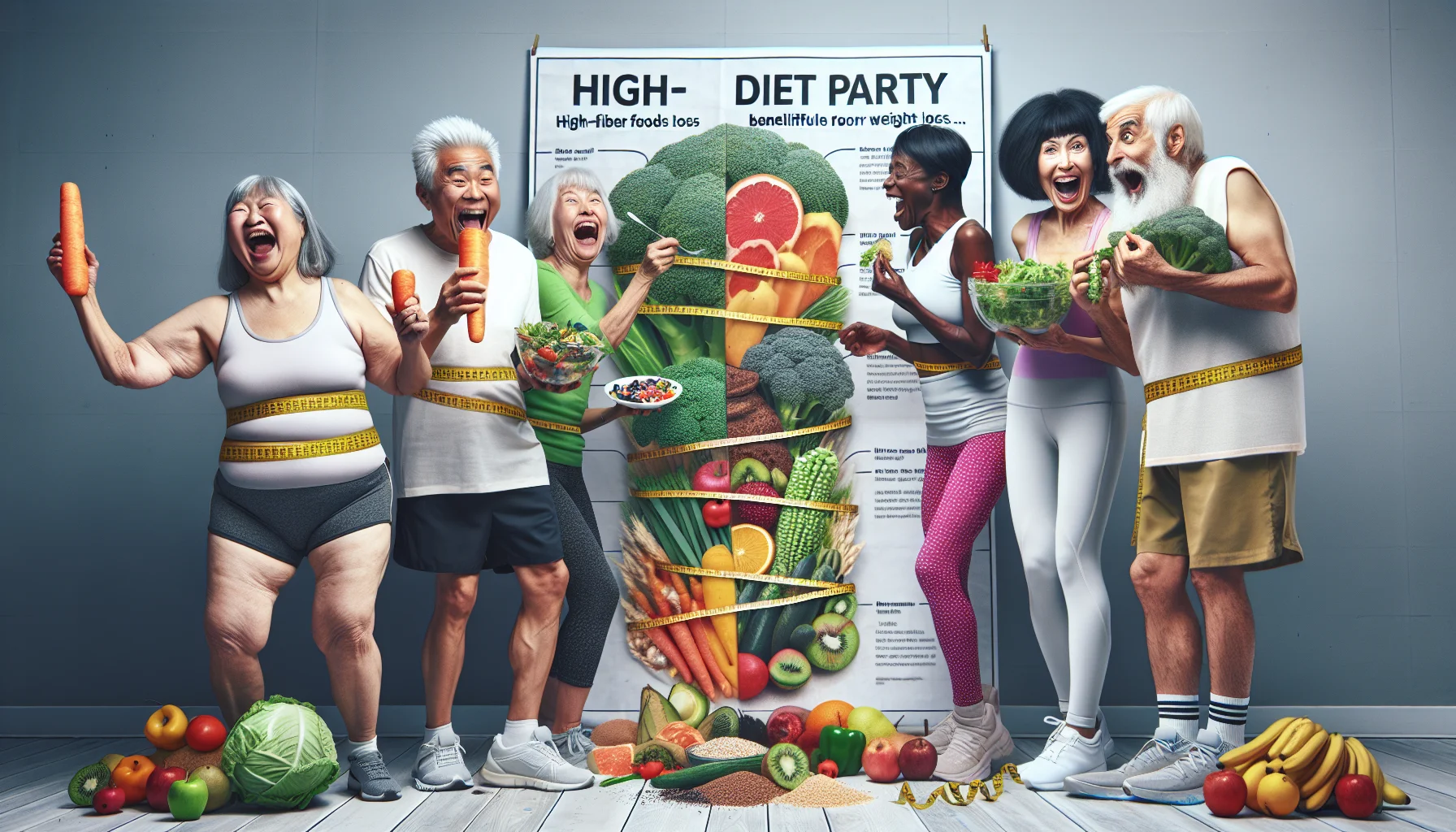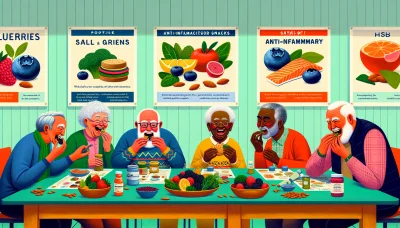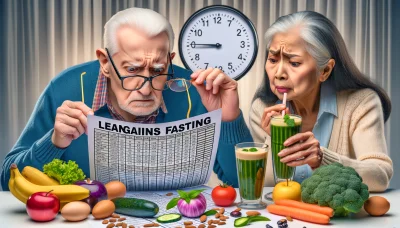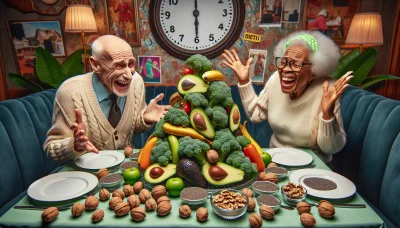High-fiber foods chart for weight loss Quiz
Test Your Knowledge
Question of
Understanding High-Fiber Foods for Weight Loss
Benefits of Fiber in Your Diet
Fiber is a powerhouse when it comes to weight loss! It adds bulk to your diet without adding extra calories, keeping you full longer. This feeling of fullness can help you control your appetite and resist the urge to overeat. A diet rich in fiber can be a game-changer for anyone looking to manage their weight effectively.
But the perks don't stop there! Fiber does wonders for your overall health too. It helps maintain bowel health, lowers cholesterol levels, and controls blood sugar levels. By including high-fiber foods in your diet, you're not just slimming down; you're also taking a big step towards a healthier life!
Satiety and Weight Management
Ever heard of the term 'satiety'? It's that blissful feeling of fullness that stops us from reaching for another snack. Fiber is satiety's best friend! By slowing down the emptying of the stomach, fiber keeps hunger pangs at bay. This natural appetite suppressant can be a key ally in your weight loss journey.
Weight management is all about balance, and fiber helps you find that balance by regulating your body's use of sugars, helping to keep hunger and blood sugar in check. Imagine eating less but feeling more satisfied that's the magic of fiber for weight management!
Health Advantages Beyond Weight Loss
Beyond helping with weight loss, fiber has an impressive list of health benefits. It acts like a broom, sweeping through your digestive system and cleaning out waste. This process can prevent constipation and even reduce the risk of colon cancer.
Fiber's health benefits are truly far-reaching it can also aid in reducing the risk of heart disease and type 2 diabetes. Plus, certain types of fiber act as prebiotics, feeding the good bacteria in your gut and improving gut health. Who knew something as simple as fiber could do so much?
Types of Dietary Fiber
Soluble Fiber: Roles and Sources
Soluble fiber is like a gel-forming superhero in your digestive tract! It binds with fatty acids, prolongs stomach emptying time so sugar is released and absorbed more slowly. This type of fiber helps lower total cholesterol and LDL (bad) cholesterol, thus reducing the risk of heart disease.
You'll find soluble fiber in an array of delicious foods! Think oats, peas, beans, apples, citrus fruits, carrots, barley and psyllium. Just imagine starting your day with a steaming bowl of oatmeal topped with apple slices you're not just treating your taste buds; you're giving your body a dose of this amazing nutrient!
Insoluble Fiber: Functions and Foods
Insoluble fiber is the tough guy that doesn't dissolve in water. It adds bulk to waste in the digestive system, which helps keep you regular and prevents constipation. This type of fiber is crucial for intestinal health and waste removal.
Ready to add more insoluble fiber to your diet? Whole-wheat flour, wheat bran, nuts, beans and vegetables such as cauliflower, green beans and potatoes are great sources. Adding these foods into meals not only boosts health but also adds exciting textures and flavors.
How Fiber Affects Metabolism
The Impact on Digestion
Fiber has a phenomenal effect on digestion! It increases stool bulk and speeds up its passage through the gut. This efficient process means less time for harmful substances to linger in your system.
- *
- Avoid refined carbs: These are low in fiber content compared to their whole-grain counterparts. *
- Increase water intake: Fiber works best when you're well-hydrated. *
- Eat varied sources: Different fibers have different effects on digestion. *
- Ditch peeling: The skins of fruits and vegetables often contain high amounts of fiber. *
- Incorporate legumes: Beans and lentils are packed with both soluble and insoluble fibers.
Creating a Balanced High-Fiber Diet
Daily Fiber Intake Recommendations
Meeting your daily fiber intake is crucial for maintaining digestive health and enhancing satiety. For adults, the recommended dietary fiber intake is around 25 grams for women and 38 grams for men per day. However, most people consume less than half of the recommended amount, which can lead to various health issues.
Guidelines for Men and Women : It's essential to understand that dietary needs can vary based on gender. Men typically require more fiber due to their higher average calorie intake. This difference emphasizes the need for personalized nutrition plans that cater to one's specific dietary requirements.
Adjusting Fiber Intake for Weight Loss : When aiming to shed pounds, incorporating more fiber into your diet can be an effective strategy. Fiber-rich foods are generally more filling, which helps in reducing overall calorie intake. Gradually increase your fiber consumption to avoid digestive discomfort.
Incorporating Fiber into Meals
A well-rounded diet includes fiber at every meal. Start with whole grains like oatmeal or bran cereals instead of refined options. Including fruits with breakfast, such as berries or bananas, can also give you a fiber boost right from the start of your day.
High-Fiber Breakfast Ideas : Kickstart your morning with options like chia seed pudding, avocado toast on whole-grain bread, or smoothies packed with leafy greens and fibrous fruits. These choices not only fuel you up but also contribute significantly to your daily fiber goal.
- Lunch and Dinner Options Rich in Fiber: For later meals, focus on incorporating vegetables like broccoli or Brussels sprouts, and opt for brown rice or quinoa over white rice or pasta. Legumes such as lentils and chickpeas are also excellent sources of fiber.
- Choose salads loaded with mixed greens, nuts, and seeds for a satisfying crunch that's full of fiber.
- Soups and stews with beans and vegetables are comforting ways to pack in the fiber during colder months.
- When making sandwiches or wraps, always choose whole-grain bread or tortillas to elevate your fiber intake effortlessly.
Snacks and Desserts with High Fiber
Healthy Snacking for Weight Control : Snacking smartly is vital when you're trying to maintain or lose weight. Opt for snacks like air-popped popcorn, raw veggies with hummus, or nuts which are not just delicious but also provide that much-needed dietary fiber.
Fruits such as apples or pears with their skin on make excellent snacks too. They are portable, easy to eat on-the-go, and packed full of fibers.
Fiber-Rich Treats to Satisfy Sweet Cravings : When it comes to desserts, don't despair! You can still indulge in sweet treats by choosing options like dark chocolate-covered almonds or baked pears sprinkled with cinnamon. These desserts help satisfy your sweet tooth while contributing beneficial fibers.
High-Fiber Foods Chart Breakdown
Vegetables and Legumes
Vegetables and legumes are powerhouses of nutrition, offering not just essential vitamins and minerals but also a significant amount of dietary fiber. Integrating a variety of these into your diet can lead to improved digestive health and sustained energy levels. They're versatile, delicious, and absolutely critical for maintaining a balanced diet.
Including a broad range of vegetables in your meals ensures you get both soluble and insoluble fiber. This diversity is key to fostering a healthy gut microbiome, which is linked to numerous health benefits. Legumes, in particular, are an economical source of protein and fiber, making them an excellent choice for anyone looking to boost their intake.
Leafy Greens and Their Fiber Content
Leafy greens such as spinach, kale, and swiss chard are not only rich in nutrients like iron and vitamin K but also provide a good amount of fiber. These greens can be easily incorporated into meals in various formsraw in salads, blended into smoothies, or cooked in soups and stews. They're an easy win on the path to a healthier lifestyle!
The fiber found in leafy greens aids in digestion and promotes feelings of fullness, contributing to weight management. By incorporating these vegetables regularly into your diet, you take crucial steps towards preventing chronic diseases while keeping your meals exciting and flavorful.
Beans, Peas, and Lentils as Fiber Staples
Beans, peas, and lentils stand out as champions of the legume family when it comes to fiber content. They're incredibly effective at regulating blood sugar levels due to their low glycemic index. A diet rich in these foods can help manage diabetes and reduce the risk of heart disease.
Lentils especially offer an impressive fiber-to-calorie ratio, making them a preferred choice for those monitoring their caloric intake. Not to mention they're versatileperfect for soups, salads, or as a meat substitute in many recipes. They're truly a must-have pantry staple for health-conscious individuals!
Fruits with the Highest Fiber
Fruits are not just sweet treats; they're also packed with vitamins, antioxidants, and yesfiber! The natural sugars found in fruits come with the benefit of high dietary fiber which helps balance blood sugar spikes. Including a range of fruits in your diet is an enjoyable way to meet your daily fiber needs.
The beauty of fruit lies not only in its nutrient content but also in its convenience as a snack or dessert option. It's nature's ready-made snack packtasty and nutritious without the need for processing or added sugars.
Berries and Pome Fruits for Daily Intake
Berries such as raspberries, blackberries, strawberries, and blueberries are among the top choices when it comes to fiber-rich fruits. They're perfect for topping cereals or yogurts or simply snacking on throughout the day. Their high antioxidant content complements their fiber profile beautifully.
Pome fruits like apples and pears retain most of their fiber content in their skins. So don't peel themjust give them a good wash! These fruits not only contribute to your daily fiber goals but also provide hydration due to their high water content.
Tropical Fruits as Fiber-Rich Alternatives
Tropical fruits such as mangoes, pineapples, and papayas offer an exotic twist to your fiber intake. These vibrant fruits add an exciting flair to any meal while packing a substantial fibrous punch that supports digestion.
- Mangoes: A great source of both soluble and insoluble fiber which aids digestion.
- Pineapples: Contains unique enzymes that can help break down proteins.
- Papayas: Have an enzyme called papain that assists with digestion alongside its fiber content.
Integrating High-Fiber Foods into Popular Diets
Paleo and High-Fiber Compatibility
The Paleo diet emphasizes whole foods, but it can be challenging to include high-fiber options due to the exclusion of grains. However, by incorporating a variety of fruits, vegetables, and nuts, one can easily boost fiber intake while adhering to Paleo principles. Vegetables like broccoli and Brussels sprouts are Paleo-friendly and high in fiber.
Seeds such as chia and flaxseeds are excellent sources of fiber that align with the Paleo diet's focus on ancient, unprocessed foods. Including these in your diet can enhance digestive health without compromising Paleo guidelines. Fruits like berries and pears also offer a sweet treat along with a fiber boost.
Navigating Paleo with Fiber-Rich Foods
To successfully integrate high-fiber foods into a Paleo diet, focus on the diversity of produce. Root vegetables like sweet potatoes and carrots have the dual benefit of being Paleo-compliant and rich in dietary fiber. Leafy greens are another powerhouse for both nutrients and fiber.
It's essential to be creative with food preparation to keep the diet interesting. For example, using spaghetti squash as a substitute for traditional pasta increases both the flavor profile and the fiber content of your meals.
Adapting Paleo Recipes for Increased Fiber
Adaptation is key when looking to increase dietary fiber within the constraints of a Paleo diet. Utilizing coconut flour or almond flour in place of grain-based flours not only complies with Paleo requirements but also adds a considerable amount of dietary fiber to recipes such as breads or pancakes.
Incorporating more nuts and seeds into recipes is another effective way to up the fiber content. They can be added to salads, used as toppings for main dishes, or even blended into smoothies for an extra nutrient kick.
Keto Diet with a Focus on Fiber
The ketogenic diet prioritizes fats over carbs, which often results in lower fiber intake. However, it is possible to maintain a healthy level of dietary fiber while keeping carbs in check. Focus on non-starchy vegetables that provide both micronutrients and fiber without disrupting ketosis.
Avocados are an exceptional choice for those on a keto diet; they're high in healthy fats and remarkably rich in fiber. This makes them an ideal ingredient for maintaining ketosis while supporting digestive health.
High-Fiber, Low-Carb Food Choices
- Select fibrous greens like kale and spinach that have minimal impact on carb limits but are dense with nutrients.
- Incorporate seeds such as chia or flaxseeds into meals or snacks for an easy fiber increase without adding too many carbs.
- Opt for berries like raspberries or blackberries which offer high-fiber content with fewer carbs than other fruits.
- Make use of nuts like almonds or pecans sparingly due to their higher calorie content but beneficial fiber addition.
- Consider using psyllium husk powder as a supplement; it's pure fiber that aids keto dieters in reaching their daily goals without excess carbs.
Balancing Ketosis with Adequate Fiber Intake
To balance ketosis with adequate fiber intake, monitor your vegetable choices carefully. Choose those that provide more bang-for-your-buck regarding nutrients per carb ratio. Artichokes and bell peppers are excellent examples that fit well within keto constraints while providing essential fibers.
Eating whole foods rather than processed keto-friendly products ensures you receive all possible natural fibers from your diet. Whole foods typically contain more nutrients overall compared to their processed counterparts which often lose fibers during manufacturing processes.
Vegetarian and Vegan Diets for Fiber Maximization
Vegans and vegetarians naturally consume diets rich in high-fiber foods through their emphasis on plant-based eating. Legumes, whole grains, fruits, and vegetables are staples that contribute significantly to daily fiber intake while providing essential vitamins and minerals.
To maximize these benefits, vegetarians should include diverse protein sources like lentils or chickpeas that are not only rich in protein but also packed with dietary fiber crucial for maintaining gut health.
Plant-Based Sources of High Fiber
Foods such as beans, peas, lentils, oats, quinoa, and barley are fantastic plant-based sources of high fiber suitable for both vegetarian and vegan diets. These ingredients can serve as the foundation for various dishes ranging from hearty stews to refreshing salads while delivering substantial amounts of dietary fibers.
Including a wide array of colorful fruits and vegetables ensures a broad spectrum of fibers along with other vital nutrients. Each color represents different phytonutrients beneficial to health beyond just their fiber content.
Overcoming Challenges with High-Fiber Diets
Dealing with Digestive Adjustments
Embarking on a high-fiber diet can initially be a shock to the system. The body may need time to adapt to increased fiber levels, which is why it's crucial to introduce changes gradually. A sudden influx of fiber can lead to discomfort, so patience is key.
Easing into a High-Fiber Diet
Transitioning smoothly into a high-fiber diet involves starting with small amounts and progressively increasing your intake. This allows your digestive system to adjust without becoming overwhelmed. Incorporating a variety of fiber sources also helps prevent any one type from causing issues.
Managing Gas and Bloating
To mitigate gas and bloating commonly associated with high-fiber diets, strategic meal planning is essential. Combining high-fiber foods with probiotics can enhance gut health and reduce discomfort. It's also beneficial to identify specific foods that may trigger bloating and limit their consumption.
Ensuring Adequate Hydration
The Importance of Water in a Fiber-Rich Diet
Fiber absorbs water, making hydration exceptionally important when increasing fiber intake. Without sufficient water, fiber cannot move effectively through the digestive system, potentially leading to constipation. Therefore, staying well-hydrated is non-negotiable for those on high-fiber diets.
Tips for Increasing Daily Fluid Intake
- Carry a reusable water bottle throughout the day as a constant reminder to drink water.
- Infuse water with fruits or herbs for added flavor that encourages more frequent sipping.
- Set regular alarms or use apps designed to prompt you to hydrate at intervals during the day.
- Incorporate high-water-content foods into your meals, such as cucumbers, tomatoes, and watermelon.
- Begin each meal with a glass of water to ensure fluid intake before eating.
Balancing Nutrients While Increasing Fiber
Avoiding Nutrient Deficiencies
In the quest for more fiber, it's vital not to neglect other essential nutrients. Ensuring a balanced diet while upping fiber can ward off deficiencies. Diverse food choices across all food groups support overall nutritional balance while achieving your fiber goals.
Pairing High-Fiber Foods with Other Nutrients
Careful pairing of high-fiber foods with protein, healthy fats, and vitamins ensures a well-rounded diet. For example, adding nuts or seeds to salads boosts both fiber and protein intake simultaneously. These combinations are not only nutritious but also enhance satiety and taste.
Tracking Progress and Results
Setting Realistic Weight Loss Goals with Fiber
Embarking on a weight loss journey starts with setting achievable goals. Including fiber in your diet adds bulk and helps you feel full longer, which can lead to a natural reduction in calorie intake. Establishing realistic weight loss targets, enhanced by fiber-rich foods, paves the way for sustainable progress.
Breaking down your ultimate goal into smaller, attainable milestones creates a roadmap for success. Adding fiber to each meal can act as a strategic approach to reaching these milestones. Celebrate each achievement to stay motivated and on track!
Establishing Attainable Milestones
Milestones act as checkpoints on your weight loss journey. They should be specific, measurable, achievable, relevant, and time-bound (SMART). Incorporating dietary fiber helps manage hunger and can make these milestones more attainable by supporting gradual, consistent weight loss.
It's not just about the scale; non-scale victories such as improved digestion and increased energy levels are also significant indicators of progress. Recognize these milestones as part of the comprehensive benefits of a high-fiber diet.
Monitoring Changes in Body Composition
Weight is not the only measure of health; body composition provides a clearer picture of progress. A high-fiber diet can influence body fat percentage positively by improving metabolism and reducing visceral fat. Regularly tracking these changes can offer insights beyond what you see on the scale.
Tools like DEXA scans or bioelectrical impedance analysis provide accurate measurements of body composition changes. With these methods, you can see the impact of a high-fiber diet on muscle mass and fat distribution, reinforcing the importance of dietary choices in weight management.
The Role of Fiber in Long-Term Weight Management
- Eat Diverse Fiber Sources: Incorporate a variety of fruits, vegetables, whole grains, and legumes to get both soluble and insoluble fiber.
- Stay Hydrated: Drinking ample water helps fiber do its job effectively, preventing constipation and aiding digestion.
- Avoid Overdoing It: Gradually increase your fiber intake to avoid gastrointestinal discomfort and allow your body to adjust.
- Mind Your Portions: While fiber is beneficial for weight loss, be mindful of portion sizes to maintain caloric balance.
- Combine with Protein: Pairing fiber with protein can enhance satiety and support muscle maintenance during weight loss.
Maintaining Weight Loss with a High-Fiber Lifestyle
Maintaining weight loss is often more challenging than losing it. A high-fiber diet promotes satiety which helps prevent overeating. It's crucial to adopt a lifestyle that views high-fiber food choices as permanent rather than temporary measures.
Fiber's role extends beyond just initial weight loss; it's vital for gut health and metabolic function. Consistently including fiber in your diet contributes to overall well-being and aids in keeping those pounds off long-term.
Adapting Your Diet as Your Body Changes
Your nutritional needs evolve as you lose weight. A high-fiber diet must also adapt to these changes. Adjusting fiber intake based on activity level, current weight, and overall health ensures that your diet continues to support your bodys needs.
Balancing different types of fiberssoluble for heart health and insoluble for digestive healthis key as your body changes. Tailoring your fiber sources ensures optimal benefits at every stage of your weight management journey.
Success Stories: Before and After High-Fiber Diets
The transformative power of high-fiber diets is best showcased through personal success stories. These narratives highlight the undeniable link between increased dietary fiber and significant weight loss achievements. They serve as powerful testimonies that inspire others on similar paths.
Personal Journeys of Weight Loss
Every story is unique, with individuals overcoming personal challenges through perseverance and dietary changes. Adding high-fiber foods plays a central role in their journeys towards healthier lives. Such stories underscore the adaptability required to maintain these lifestyle changes over time.
Lessons Learned from Long-Term Dietary Changes
The collective wisdom gained from long-term adherence to high-fiber diets offers invaluable lessons for sustainable health practices. Understanding the importance of consistency, flexibility in ones diet plan, and listening to ones body are fundamental takeaways from these experiences.












